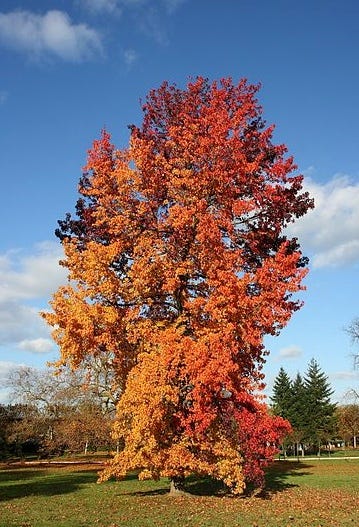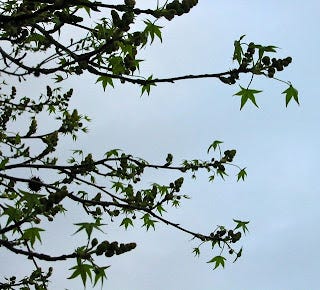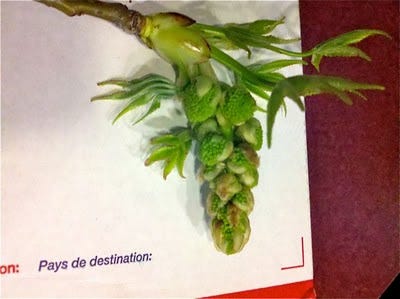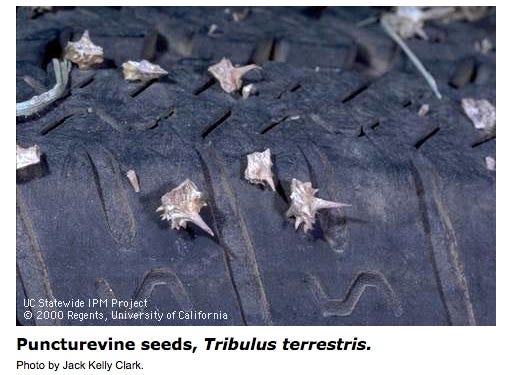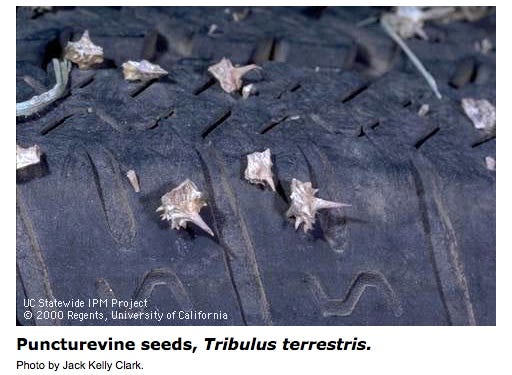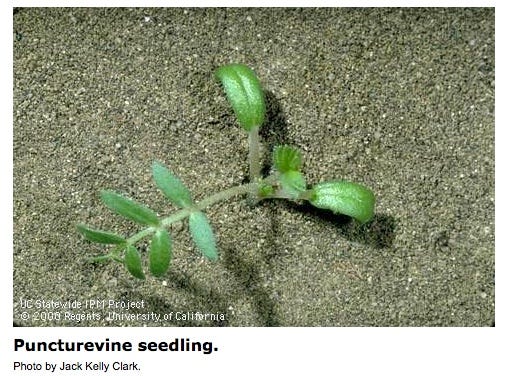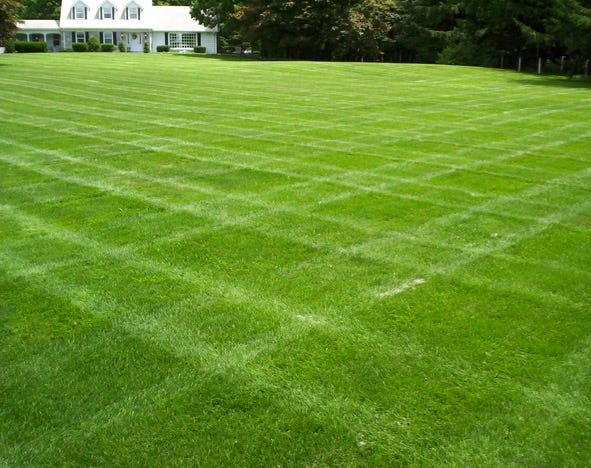Watch Your Step! Puncturevine Weed and Liquidambar Trees
Episode 154 of the Garden Basics Podcast dealt with these two prickly topics.
On Episode 154 of the Garden Basics with Farmer Fred podcast, we tackled two prickly topics: the spiky seed balls of puncturevine weed and the “sputniks” of liquidambar (sweet gum) trees. Yes, those sharply pointed spheres that fly in the autumn breeze do resemble Eisenhower-era, low-earth orbiting Russian weapons of no destruction. Plus, we found out why you have a lawn. Blame your heritage, and advertising.
OUCH! Part 1
The Sweet Gum: Friend or Foe?
University of California Davis Arboretum and Public Garden Superintendent Emeritus Warren Roberts thought the liquidambar tree (aka the Sweet Gum) should be the star of the episode’s Plant of the Week segment, primarily for its fall color. OK, point taken. Literally. If you’ve ever stepped on a fallen liquidambar seed ball, you know what I mean. Stay for the brilliant fall color, but get out of the way of those seed balls. As I (not jokingly) mentioned to Warren, encourage your neighbors to plant the liquidambar so you can admire them from afar. P.S. it should be a neighbor across the street, not next door or behind you.
Still, the issue remains for anyone within airborne or rolling distance of those liquidambar seed balls: How do you stop the tree from producing them? Here are two ideas. The first is very satisfying:
The second method of controlling liquidambar seed balls is less noisy, but more iffy.
Stopping Those Nasty Liquidambar Balls
If you are tiptoeing around the sharp, spiky seedpods of liquidambar (sweet gum) trees throughout the year, early to mid-spring is the time to control their development.
Peering into your liquidambar tree in early spring...
look for this rather unremarkable flower:
If you see those, it's the time to spray a product containing the growth regulator, Ethephon. One such product is Monterey Lawn & Garden Products' Florel. Thoroughly sprayed onto the blooms of an ornamental tree that produces undesirable fruit, the chemical causes the blossoms to abort, stopping fruit production. In the case of the liquidambar tree, the fruit are those sharp seedpods that are the bane of barefooters everywhere.
According to Monterey, "the best time to spray Florel is when the flowering plant is in the mid to full bloom stage. The ideal time for spraying sweet gum (liquidambar) is right after the tiny balls form below the catkin. After application, these tiny balls simply dry up and fall off."
According to the product label, Florel will also control undesirable fruit on other ornamental plants such as Buckeye, Crabapple, Carob, Cottonwood, Elm, Flowering pear, Horsechestnut, Maple, Oak, Olive, Pine, Sour orange and Sycamore trees.
A few notes about applying this growth regulator:
• Read and follow all label directions.
• Timing is critical. There is a short window of opportunity to spray while the blossoms are in mid to full bloom.
• Thorough coverage is necessary. Monterey suggests it takes about 5 to 20 gallons of the Florel and water mixed together to coat the flowers of a tree, up to the point of runoff. One quart of Florel makes about 10 gallons of mix.
• The product works best when applied during daytime temperatures of 65-90 degrees.
• Use the mixed product immediately. When first combined, the mix has a very acid pH of 2.5; but that acidity decreases as the mix hydrolizes, reducing its effectiveness.
• And how do you reach those blossoms that are out of the reach of your sprayer? That's when it's time to call in the arborist with a crane.
And, good luck.
OUCH! Part 2 (where you learn a new word for Scrabble or Words with Friends)
Puncturevine, which was recently voted “most troublesome weed” in an informal Get Growing with Farmer Fred Facebook survey. The “trouble” is in its name: it’s sharp seed balls share a distinction with an ancient “area denial weapon”, the caltrop (your new Scrabble word): no matter where it lands, one of its three or four sharp spikes will be pointed upward, aimed directly at your feet, your animals’ paws, and your bicycle tires. Pain and suffering will commence in all three cases. The University of California Ag and Natural Resources’ Integrated Pest Management service has information on how to control this summer weed, which tends to occupy sunny, dry places. Also, our favorite retired college horticulture professor, Debbie Flower, and I offer tips and advice for dealing with puncturevine in Episode 154 of the Garden Basics podcast.
Here’s what this devil of the dirt looks like:
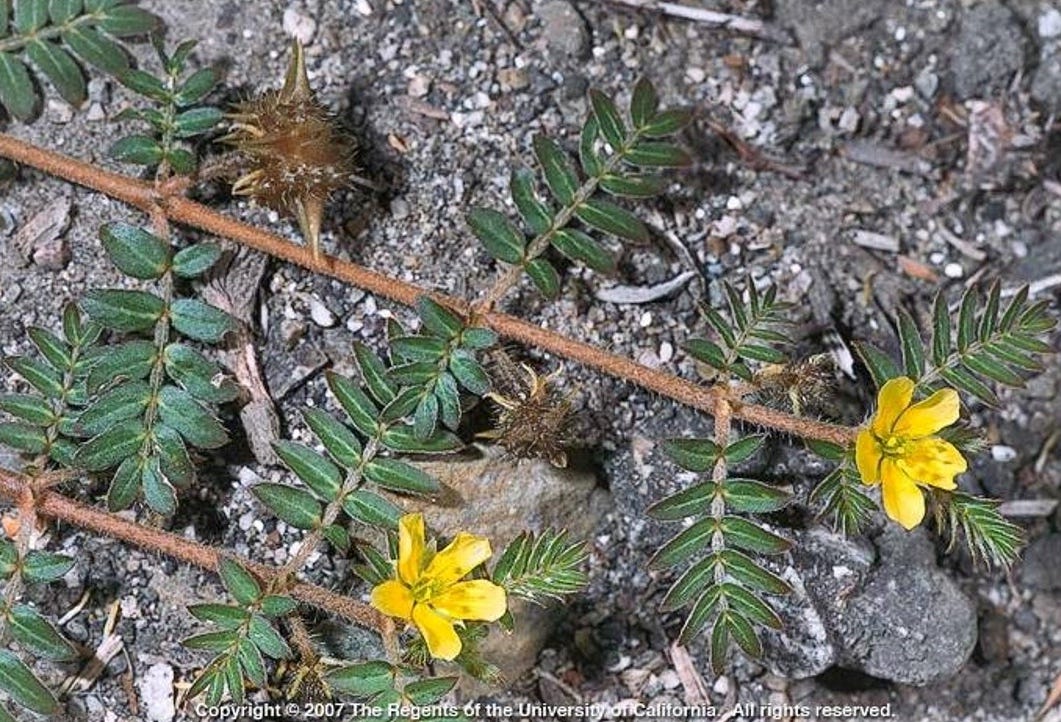
The best time to hoe out this pest weed? When it looks like this:
Why Big Lawns?
The opening segment of Episode 154 tackles a topic I have often wondered about: what is it about us that makes us want to turn the majority of our yard space into a lawn? Lawns aren’t easy care; in fact, you’ll spend more time and/or money tending to a lawn than you would a yardful of annuals, perennials, fruits, vegetables, shrubs and trees. Turfgrass doesn’t attract much in the way of the garden good guys: pollinating insects, beneficial insects, or birds. You can’t eat it. Dogs and cats only eat it when they feel like puking. I am not against lawns. I think kids and pets and their overlords should enjoy a bit of the scenic greenery. It’s calming. But do you really need thousands and thousands of square feet of this high-maintenance uselessness?
My daughter, the college anthropology professor, explained to me once that I should be taking my “cranky old man” wrath out on Fred Flintstone and his contemporaries. Humankind has always wanted an unobstructed view out their front door, to see any oncoming trouble (including fire). So, areas around the domicile were cleared of tall brush. OK, it’s in our DNA.
And according to Thomas Mickey, author of the book, “America’s Romance with the British Garden”, there are major suspects, still with us today, that are propagating the view (as Fred Flintstone might say, “Literally. Yabba-dabba-do!”) that lawns are good. That culprit? Marketing students who have had jobs at catalog companies, going back to the 1800’s. Mickey also points a finger at real estate agents of days gone by, who encouraged new American homeowners to emulate the wealth of British estates by installing wide swaths of green lawn. Oh, and seductive garden catalogs helped sell that dream, too. Give that segment a listen.
California lawn owners: don’t forget, the taxpayers there will pay you to remove your lawn!
Thanks for Subscribing and Spreading the Word About the Garden Basics with Farmer Fred newsletter, I appreciate your support.
And thank you for listening to the Garden Basics with Farmer Fred podcast! It’s available wherever you get your podcasts. Please share it with your garden friends.
As an Amazon Associate, I earn from qualifying purchases from some of the underlined links in the newsletter. This is how I am trying to keep this a free newsletter. And as long as you buy whatever you want from Amazon using any of those links to get into the Amazon site, I get a few pennies. Thank you.




